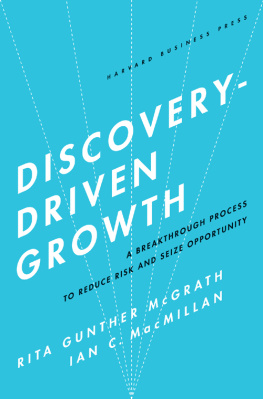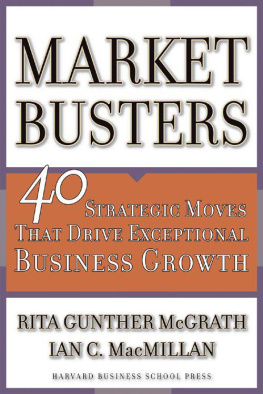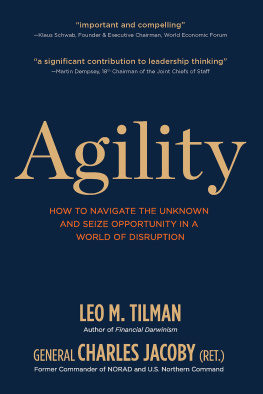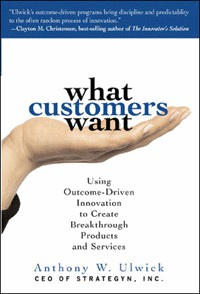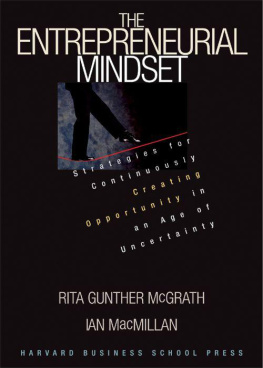McGrath Rita Gunther - Discovery-driven growth opportunity : a breakthrough process to reduce risk and seize opportunity
Here you can read online McGrath Rita Gunther - Discovery-driven growth opportunity : a breakthrough process to reduce risk and seize opportunity full text of the book (entire story) in english for free. Download pdf and epub, get meaning, cover and reviews about this ebook. City: Boston, Mass., year: 2009, publisher: Harvard Business Press, genre: Business. Description of the work, (preface) as well as reviews are available. Best literature library LitArk.com created for fans of good reading and offers a wide selection of genres:
Romance novel
Science fiction
Adventure
Detective
Science
History
Home and family
Prose
Art
Politics
Computer
Non-fiction
Religion
Business
Children
Humor
Choose a favorite category and find really read worthwhile books. Enjoy immersion in the world of imagination, feel the emotions of the characters or learn something new for yourself, make an fascinating discovery.
- Book:Discovery-driven growth opportunity : a breakthrough process to reduce risk and seize opportunity
- Author:
- Publisher:Harvard Business Press
- Genre:
- Year:2009
- City:Boston, Mass.
- Rating:4 / 5
- Favourites:Add to favourites
- Your mark:
- 80
- 1
- 2
- 3
- 4
- 5
Discovery-driven growth opportunity : a breakthrough process to reduce risk and seize opportunity: summary, description and annotation
We offer to read an annotation, description, summary or preface (depends on what the author of the book "Discovery-driven growth opportunity : a breakthrough process to reduce risk and seize opportunity" wrote himself). If you haven't found the necessary information about the book — write in the comments, we will try to find it.
McGrath Rita Gunther: author's other books
Who wrote Discovery-driven growth opportunity : a breakthrough process to reduce risk and seize opportunity? Find out the surname, the name of the author of the book and a list of all author's works by series.
Discovery-driven growth opportunity : a breakthrough process to reduce risk and seize opportunity — read online for free the complete book (whole text) full work
Below is the text of the book, divided by pages. System saving the place of the last page read, allows you to conveniently read the book "Discovery-driven growth opportunity : a breakthrough process to reduce risk and seize opportunity" online for free, without having to search again every time where you left off. Put a bookmark, and you can go to the page where you finished reading at any time.
Font size:
Interval:
Bookmark:
Copyright 2009 Rita Gunther McGrath and Ian C. MacMillan
All rights reserved
No part of this publication may be reproduced, stored in, or introduced into a retrieval system, or transmitted, in any form or by any means (electronic, mechanical, photocopying, recording, or otherwise), without the prior permission of the publisher. Requests for permission should be directed to , or mailed to Permissions, Harvard Business School Publishing, 60 Harvard Way, Boston, Massachusetts 02163.
First eBook Edition: March 2009
ISBN: 978-1-59139-685-7
From Rita
MacMillan helped, too.
From Ian
To Jean, Sandy, Adam, Eric, KC, Milo, Faren,
in fact the whole gang
Despite its centrality, driving corporate growth is paradoxicaleveryone recognizes its importance, yet it is easy to get it wrong. The result is that every day, in offices and conference centers, in meeting rooms and airports, anxious executives in well-established companies worry deeply about how they are going to lead strategic growth in their organizations. CEOs worry about how to deliver the growth they pledged to their boards, CFOs worry about how they will appease a growth-hungry stock market, and COOs and their direct reports worry about how they are going to deliver the growth targets that were promised at the last stockholders meeting, while still retaining corporate efficiency. Our argument is that their worries are well grounded. The time-tested, comfortable approaches to everyday management dont work well in dynamic, rapidly changing, and therefore cruelly uncertain environments. Consequently, while many companies invest in growth initiatives, the results are uneven.
Weve all heard many cautionary tales about well-managed and successful companies that stumbled disastrously when they tried to pursue opportunities for growth. Revlons 2006 introduction and almost immediate abandonment of Vital Radiance cosmetics (a $100-million-plus flop), Michelins 2008 withdrawal of the PAX run-flat tire system, and even fabled General Electrics exploration of new financial products are just a few examples of smart companies whose processes for managing growth seem to have let them down badly. But failing to grow is not an option. Todays core business is highly unlikely to be an engine of growth for tomorrow. Accordingly, investors will see companies without a compelling approach to growth as nothing more exciting than a ten-year bond.
For over two decades, the two of us have been studying why so many well-conceived, carefully planned growth programs go wrong and why so many good companies just cant seem to get traction from their growth initiatives. Weve also gained experience with companies that are getting it right and enjoying the growth and prosperity that ensue. In our many years of working with companies such as Nokia, Air Products and Chemicals, 3M, DuPont, IBM, and many others, weve distilled practices that allow managers to choose better strategic growth projects, reduce the risk of these projects, and either execute them with relentless success or discontinue them at very low cost. This book is the result.
Our core thesis is that companies that use conventional methodologies to pursue exceptional growth are doomed to be disappointed. They will simply not be able to accomplish growth that allows them to break out of the pack and deliver exceptional results. Consider how IBM learned, painfully, that its one-size-fits-all management style was crippling its growth efforts and how the company needed to operate differently.
In April 2001 we were sitting with a few folks from the strategic planning office at IBM. As youll remember, IBM was virtually given up for dead when Lou Gerstner was appointed CEO in 1993 and began what he later would describe as a transformation effort. Throughout much of the 1990s, the company focused on ripping out costs, fixing individual businesses, and generally getting its house in order. But that clearly wasnt going to be enough to restore Big Blue to its former glory as the most desirable of the blue chips. Despite sincere efforts, growth projects stalled, and Gerstner wanted to get to the bottom of it.
Strategy chief J. Bruce Harreld later recounted in a keynote address how the change came about:
In the early summer of 1999, we had decided to go after a new business area. So in September, there is Lou Gerstner sitting in his office on a sunny afternoon and he sees a line drawn through the project on the budget. It turns out that the executive in charge had said, due to our current cost pressures, we decided to cut back on those activities we decided to invest in in June.
Lou wrote this note, in frustration. I have had it, he said. This is a bunch of crap for this big business unit to believe that this little thing is going to have any material impact on their results for June. I want you, you and you [the colleagues who were at our meeting in 2001], to understand whats going on here. There is something systemically wrong with IBM and how we manage that we cant embrace and stay with new investments for growth.
What they found echoes the conclusions from our own research. Essentially, the techniques that IBM was using to manage its bottom line and drive efficiencytechniques that were working well for the core businesswere smothering the new growth ventures. IBM executives started to explore new disciplines, new techniques, that could help the company nurture small growth initiatives without losing sight of its core business operations.
As Harreld later put it: We needed different management systems with businesses at different stages of maturity. The new businesses, the growth businesses, needed to be protected and needed a different kind of management style. They werent like our mainframe business.
The insight learned at IBM through many painful experiences is that you cant manage growth programs using conventional approaches. This single insight profoundly changed the way the company funds, structures, and plans growth projects, to the point at which IBMs emerging business opportunity (EBO) program has become a global exemplar for how a large organization can capture new opportunities for growth.
In this book, well show you why conventional approaches are often lethal to innovative growth projects and how you can supplement these approaches. Exceptional growth can be driven from three places. You can grow your core or radically improve the performance of the core by using conventional management tools. You can create new growth platforms (sometimes called adjacencies), or you can invest in strategic options that have the potential to become future platforms. As you move more and more into new platforms and strategic options, the discovery-driven tools we describe in the book become more important. Success depends on how you create an engine for growth from your capabilities and assets and properly direct it toward new spaces, using the disciplines that make senseconventional tools if you know a lot and what we call discovery-driven tools if you dont.
Breakout growth is not only about launching bold, new initiatives. Many good growth programs begin first with incremental growth, which creates investment in learning where big new opportunities lie. Thats the point at which many companies go for breakout growth. Many breakout opportunities dont look that way at firstthey are the result of combining things until you finally do have a winner (Procter & Gambles Swiffer cleaning systems would be an example). There are, of course, many companies out there making what they hope will be breakout moves. What they often find out, painfully, is that they are using the wrong tools to do it and are therefore taking on risk far beyond the potential payoff. Worse, they are learning less than they could otherwise.
Font size:
Interval:
Bookmark:
Similar books «Discovery-driven growth opportunity : a breakthrough process to reduce risk and seize opportunity»
Look at similar books to Discovery-driven growth opportunity : a breakthrough process to reduce risk and seize opportunity. We have selected literature similar in name and meaning in the hope of providing readers with more options to find new, interesting, not yet read works.
Discussion, reviews of the book Discovery-driven growth opportunity : a breakthrough process to reduce risk and seize opportunity and just readers' own opinions. Leave your comments, write what you think about the work, its meaning or the main characters. Specify what exactly you liked and what you didn't like, and why you think so.

